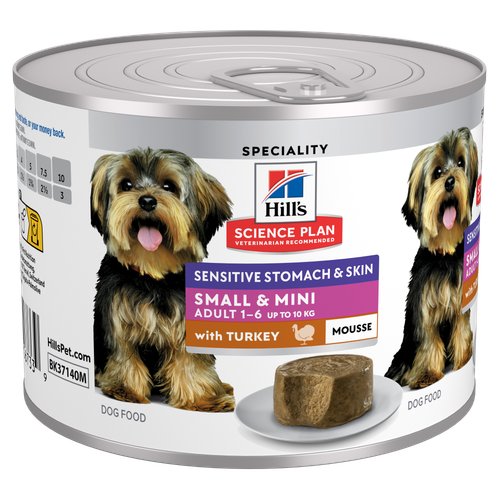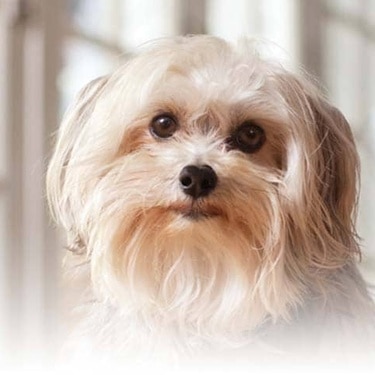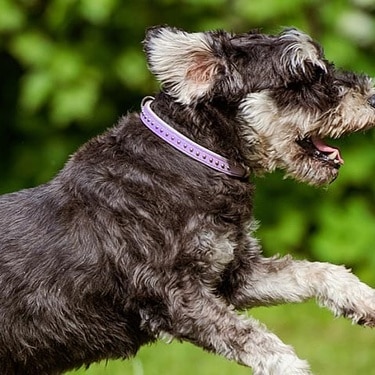
-
Find the right food for your petTake this quiz to see which food may be the best for your furry friend.Find the right food for your petTake this quiz to see which food may be the best for your furry friend.Featured products
 Perfect Digestion Small & Mini Adult Dog Food
Perfect Digestion Small & Mini Adult Dog FoodHill's Science Plan Perfect Digestion Small & Mini Adult Dog Food with Turkey is a complete premium pet food for small breed adult dogs aged 1–6 years. This deliciously smooth mousse is precisely balanced to deliver the appropriate amount of energy and to support digestive health in adult, small breed dogs.
Shop Now Sensitive Stomach & Skin Dog Food
Sensitive Stomach & Skin Dog FoodHill's Science Plan Sensitive Stomach & Skin Adult Wet Dog Food with Chicken is a complete premium dog food for adult dogs from 1 year. This savoury tinned loaf is enriched with ingredients that support digestive health & skin care.
Shop Now Perfect Weight Small & Mini Adult Dog Food
Perfect Weight Small & Mini Adult Dog FoodHill's Science Plan Adult Small & Mini Dog Food with Turkey is a complete premium pet food for adult small dogs from 1 year old that are prone to weight gain or slightly overweight. This deliciously smooth mousse is formulated to deliver the appropriate amount of energy to support weight maintenance in adult dogs.
Shop NowFeatured products Mature Adult Wet Cat Food with Chicken
Mature Adult Wet Cat Food with Chicken
Tender chicken chunks in gravy for mature adult cats. Made with easy-to-digest ingredients, high-quality protein for lean muscle maintenance and antioxidant vitamins C+E for optimal health.
Shop Now Adult Multipack Wet Cat Food with Beef, Ocean Fish & Chicken
Adult Multipack Wet Cat Food with Beef, Ocean Fish & ChickenTender chunks in gravy for cats, with high-quality protein to maintain lean muscle. With vitamin E and omega-3s & -6s for healthy skin and balanced minerals to support healthy vital organs.
Shop Now Light Adult Multipack Wet Cat Food with Chicken & Ocean Fish
Light Adult Multipack Wet Cat Food with Chicken & Ocean FishTender chicken chunks in gravy for cats, with L-carnitine and fewer calories for ideal weight management. Packed with high-quality protein, omega-6s, and vitamin E for shiny fur and healthy skin.
Shop Now -
Dog
- Dog Tips & Articles
-
Health Category
- Weight
- Food & Environmental Sensitivities
- Urinary
- Digestive
- Joint
- Kidney
-
Life Stage
- Puppy Nutrition
- Adult Nutrition
- Senior Nutrition
Cat- Cat Tips & Articles
-
Health Category
- Weight
- Skin & Food Sensitivities
- Urinary
- Digestive
- Kidney
-
Life Stage
- Kitten Nutrition
- Adult Nutrition
Featured articles The Right Diet For Your Pet
The Right Diet For Your PetIn people, the right diet is very important. If you are eating the wrong way for your metabolism, activity level, age and lifestyle you could end up with health issues.
Read More Show some love with wet foods: a great choice for pets with health issues
Show some love with wet foods: a great choice for pets with health issuesShow some love with wet foods: a great choice for pets with health issues.
Read More Help! My Dog Doesn't Like Me & I Have a Standoffish Cat
Help! My Dog Doesn't Like Me & I Have a Standoffish CatIf you've ever thought to yourself, "My dog doesn't like me," or "Why do I have such a standoffish cat?" rest assured that you aren't the only pet parent who has these concerns.
Read More -


It’s always a pleasure to watch your dog tearing around in the fields and meadows, full of the joys of spring, but danger lurks within. Grass seeds are shaped like darts and have multiple sharp little fronds poking out of them. This shape is incredibly efficient at driving the seeds in one direction only. If ever you hold a grass seed and work it through your fingers you’ll see exactly how impossible it is to move it in the ‘wrong’ direction. This is all very well for the grass seed getting planted into soil or undergrowth, but it can be a nightmare for our dogs.
When dogs run through grass, the seeds become very easily lodged into their fur and then, through their pointy design, start edging deeper wherever they are. The two most common places that grass seeds cause issues is in the ears and feet. Dogs with floppy, furry ears, such as spaniels, and dogs with medium or long fur on their legs and feet, are prime candidates for this.
When a grass seed becomes lodged in your dog’s ear canal, it will very quickly start to wriggle its way down. This is incredibly uncomfortable and your dog will usually show very obvious signs of head-shaking and scratching at their ear. If you see this shortly after a walk, always check their ears or get to the vet as soon as you can. If left, the grass seeds will eventually work their way straight through the eardrum and cause a lot of damage.
Grass seeds are so unidirectional that they can even break skin and start migrating deeper into the body. Getting lodged between the toes is a common scenario. The seeds puncture the skin and start to work their way in. You can imagine how uncomfortable this will be for your dog. You’ll notice that they’ll spend a lot of time licking the area the seed is embedded in. Their paw will become swollen, inflamed and often infected, and your dog may start limping.


Tasty Tips
In many cases, by the time your dog gets to the vet, the seed has penetrated completely and may be tracking a long way in.
Removing grass seeds from dog fur
Seeds lodged in the ear canal can often be removed by your vet without needing to sedate your dog. We use an otoscope, which is a hollow, magnifying torch that’s used for examining ears, and long forceps to grasp the seed and extract it. Your dog will be super relieved when it pops out! If they have been in the ear for some time, or it’s very painful and inflamed, sedation or anaesthesia may be necessary.
When it comes to penetration into the paws or other areas of the body, then sedation or full anaesthesia is essential, alongside good pain relief. Grass seeds can be very difficult to find if they’ve gone a long way. They can also fragment on their journey and it can become very difficult to be sure that all the pieces are removed. Any vet will tell you that plucking an intact grass seed from deep within a swollen foot or ear is one of the most satisfying things a vet can do!
Never underestimate the dangers of grass seeds
You’ll probably be shocked to know that these, seemingly innocuous, little things have, and do kill dogs. If inhaled they can track through the lungs and cause fatal infections. Once they're in the body they can migrate almost anywhere, given enough time.
If you have a furry dog, think about keeping their fur clipped short during the spring and summer. When you return from walks, always check your dog’s whole body, including lifting the ear flaps to check for grass seeds that may have hitched a ride. This simple habit could save your dog a lot of discomfort and save you time, money and a lot of heartache.
Reviewed by Dr. Hein Meyer, DVM, PhD, Dipl-ECVIM-CA


One of our staff authors prepared this article for you
Related products

Hill's Science Plan Perfect Digestion Small & Mini Adult Dog Food with Turkey is a complete premium pet food for small breed adult dogs aged 1–6 years. This deliciously smooth mousse is precisely balanced to deliver the appropriate amount of energy and to support digestive health in adult, small breed dogs.

Hill's Science Plan Adult Small & Mini Dog Food with Turkey is a complete premium pet food for adult small dogs from 1 year old that are prone to weight gain or slightly overweight. This deliciously smooth mousse is formulated to deliver the appropriate amount of energy to support weight maintenance in adult dogs.

Hill's Science Plan Sensitive Stomach & Skin Adult Wet Dog Food with Chicken is a complete premium dog food for adult dogs from 1 year. This savoury tinned loaf is enriched with ingredients that support digestive health & skin care.

Hill's Science Plan Sensitive Stomach and Skin Small & Mini Adult Dog Food with Turkey is a complete premium pet food for small breed adult dogs aged 1–6 years. This deliciously soft mousse is enriched with ingredients that support digestive health & skin care.
Related articles

Just like every other pet owner, vets are responsible for giving their pets the best possible nutrition, exercise and care needed to keep them healthy and happy.

Dog obesity is a significant problem - learn more about helping your dog become trimmer and healthier through improved nutrition.

Understand the potential causes of excessive dog itching and how to address them. Seek relief for your dog with expert advice from Hill's Pet UK.

Discover the causes, signs, and treatments of kidney disease in dogs and find methods of supporting your dog's kidney health. Learn more at Hill's Pet UK.

Put your dog on a diet without them knowing
Our low calorie formula helps you control your dog's weight. It's packed with high-quality protein for building lean muscles, and made with purposeful ingredients for a flavourful, nutritious meal. Clinically proven antioxidants, Vitamin C+E, help promote a healthy immune system.
Put your dog on a diet without them knowing
Our low calorie formula helps you control your dog's weight. It's packed with high-quality protein for building lean muscles, and made with purposeful ingredients for a flavourful, nutritious meal. Clinically proven antioxidants, Vitamin C+E, help promote a healthy immune system.

